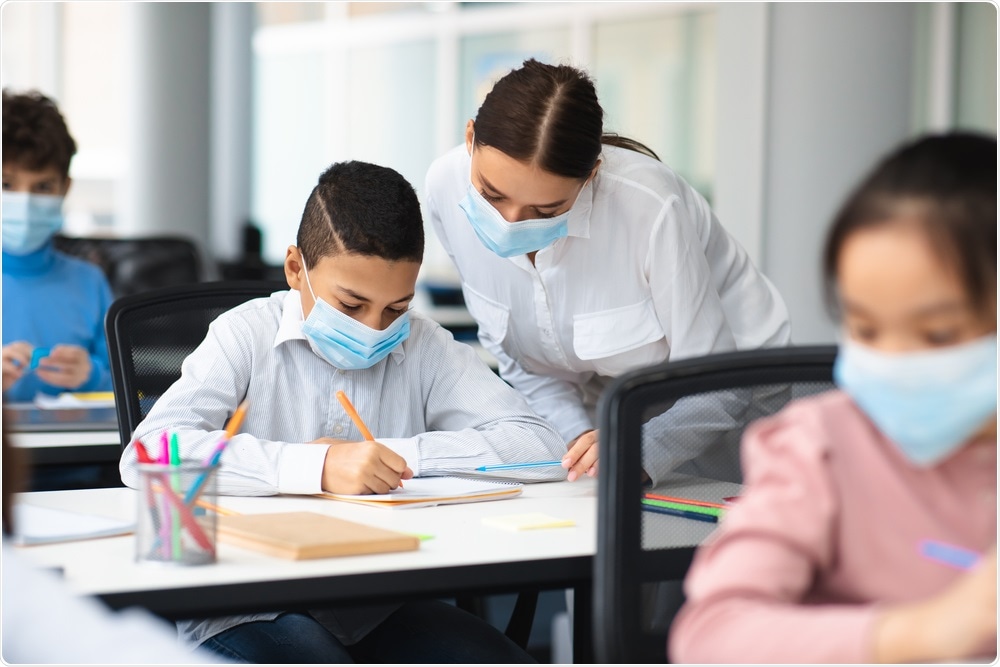The coronavirus disease 2019 (COVID-19) pandemic is caused by a highly infectious novel coronavirus known as the severe acute respiratory syndrome coronavirus 2 (SARS-CoV-2). As the rate of transmission of this ribonucleic acid (RNA) virus is extremely high, about 225 million individuals around the world, to date, have been infected.
Scientists and policymakers are trying extremely hard to formulate strategies to contain the spread of SARS-CoV-2. These strategies include medical approaches, such as COVID-19 vaccines and therapeutics, as well as non-medical approaches that involve the use of masks, social distancing, frequent hand wash, travel restrictions, and lockdown measures across countries
Study: SARS-CoV-2 circulation in the school setting: A systematic review and meta-analysis. Image Credit: Prostock-studio / Shutterstock.com
The global impact of prolonged school closures
One of the common strategies that have been implemented internationally to prevent the spread of SARS-CoV-2 is the closure of schools. This policy is based on the assumption that children may become an important vector for the spread of SARS-CoV-2.
The United Nations Educational, Scientific and Cultural Organization (UNESCO), reported that countrywide school closures had been imposed by 188 countries. From the beginning of the COVID-19 pandemic to March 2021, regular schooling has been disturbed for about 25 weeks worldwide and has thus affected approximately 1.5 billion children and youth.
According to UNESCO, the consequences of a prolonged closure of schools could be disturbing, as schools not only provide instruction on education but also contribute to the development and overall wellbeing of school-age children. Some of the adverse consequences of a prolonged closure of schools also include predictions that more than 100 million children could fall behind the minimum proficiency level in reading. Additionally, children with special needs, those living in low-income countries, or those residing in areas with poor digital connectivity, would not benefit from remote schooling and are also likely to fall behind.
The United Nations reported that over 300 million children worldwide depend heavily on meals provided by schools, which serve as their regular source of daily nutrition. Hence, the risk of an increase in malnutrition is expected among the most vulnerable groups.
Additionally, some children are at a high risk of witnessing domestic violence or suffering domestic abuse or violence while away from school. The UN also claimed that subjecting children to online platforms for remote learning has also heightened the risks of being exposed to inappropriate content and online predators.
The debate surrounding school closures
Scientists have claimed that, as compared to adults, children and young adults are less prone to SARS-CoV-2 infection. Therefore, the role of children being a vector to transmit COVID-19 is under question.
However, as this group has been mostly found to be asymptomatic or contract mild COVID-19, symptom-based testing may show a false result. This means that there is a high chance that infected children will remain undetected and unrecognized, thus increasing the chance of viral circulation in schools. This could increase the rate of community infection.
A new study
A new study published on the preprint server medRxiv* discusses existing evidence of SARS-CoV-2 transmission in an educational setting. Here, the researchers conducted systematic review and meta-analysis studies to evaluate COVID-19 transmission in schools.
In the present study, scientists included available reports on serosurveys and research on the point of incidence of SARS-CoV-2 to estimate the silent circulation of the virus in schools. The authors have also included studies on contact tracing to understand the infectivity of SARS-CoV-2 and the vulnerability of students and school staff exposed to the virus.
Researchers obtained a total of 1088 publications and followed Meta-analyses Of Observational Studies in Epidemiology (MOOSE) guidelines. All data were analyzed using random-effects models.
Study findings
The screening studies included around 120,000 students and staff in school settings. The researchers estimated the prevalence of SARS-CoV-2 in schools to be 0.31%.
A total of 112,622 contacts of children and adults were included in the contact tracing studies, which revealed limited onward viral transmission of 2.54%. Assessment of the studies on seroprevalence, which included a total of 17,879 subjects, estimated that children were 43% less likely to be seropositive as compared to adults.
The current study further revealed that schools are not hotspots for SARS-CoV-2 transmission. Even though SARS-CoV-2 infection can occur in schools, the rate of viral spread is extremely minimal when mitigation measures are properly followed. Further, researchers observed a reduced circulation of the virus and rare child-to-adult transmission occurring in school settings.
Conclusion
The authors of this study suggested that teachers and educational support staff, especially those with comorbidities, should be prioritized for COVID-19 vaccination. This initiative would protect teachers and students from being infected. Further, testing all students and staff, irrespective of the presence of any COVID-19 symptoms, would enable early detection of the disease and thereby prevent further spread of the infection.
*Important notice
medRxiv publishes preliminary scientific reports that are not peer-reviewed and, therefore, should not be regarded as conclusive, guide clinical practice/health-related behavior, or treated as established information.
